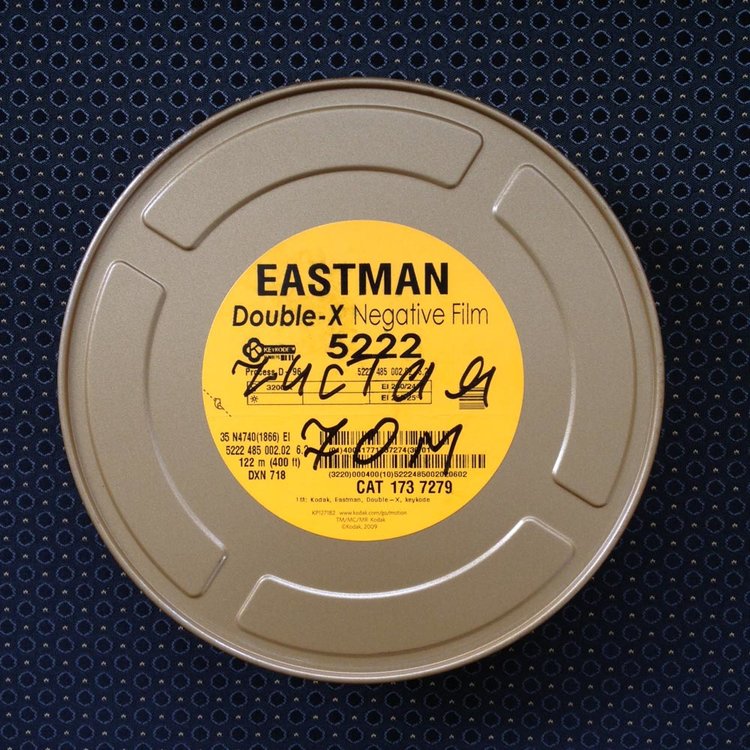Search the Community
Showing results for tags 'eastman'.
-
More traditional forms of tampering with ones negative in the processing stage include over or under-developing your film, doing a bleach-bypass, or having the film cross processed. Cross processing refers to using a different form of chemical solution and/or pipeline to develop one specific kind of film. I have recently been researching different ways to manipulate the resulting negative in the processing stage, and one idea that had never crossed my mind until now was using the ECN-1 method of development on ECN-2 film. From what I have read, both methods use the exact same chemicals with the same general workflow, only differing in the length of time and temperature used in part A of the process. Wikipedia says that ECN-1... "...involved development at approximately 25 °C for around 7–9 minutes". Firstly, has anyone here ever tried developing ECN-2 film with the ECN-1 processing method? And if so, to what results? Secondly, would anyone be able to gage what this temperature and development time difference would have on the resulting film in terms of resolution, density, dynamic range, contrast, grain, and color? Would ECN-2 film's emulsion even come off with this method, or would that be another potential problem introduced by this workflow?Would the result even be predictable, or is this method so old and unexplored with the new VISION3 stocks that results will end up without a clear pattern of cause and effect? If most people on this page advise me against developing ECN-2 film with the ECN-1 solution then I probably won't take this experiment much further. But I would love to hear your favorite method of cross processing ECN-2 film and what kind of results it ends up having on each VISION3 stock as I am interested in learning more about it. Thank you!
-
I shoot with expired film quite a lot. As a matter of fact, I would say that it's my go to. My favorite stock I've ever shot with is hands down Kodak EXR 5245 50D. I have lately realized, however, that there are a few realities about shooting on expired that I need to come to terms with quickly. It’s unreliable, it’s in short supply, it’s going extinct, and no professional production wants their investment shot on expired film. I need to move on, but frankly, I have always had a visual distaste for VISION3. I want to further pursue something I've only ever experimented with but never fully committed to in the past: emulating the photochemical characteristics of older Eastman fine grain film stocks by experimenting with exposure, density, and processing using modern Kodak film. For reference, I most often shoot on 2-Perf Techniscope with the original line of Basuch & Lomb Baltar lenses dated at the 1940s. The two Eastmancolor stocks I am most interested in trying to emulate are ECN 5248 25T (1952-1959) and ECN 5250 50T (1959-1962). About a year ago I did a short experiment on 35mm with Baltar lenses where I shot a few short reels of footage on VISION3 500T using ND filters in direct sunlight outside and had them exposed and processed in different ways. I then had them scanned in 12-bit HDR and brought them into DaVinci to level out all the footage and see how my end products differed. The four types of footage I got were underexposed one stop and developed at box speed, underexposed two stops and developed at box speed, exposed at box speed and underdeveloped one stop, and exposed at box speed and underdeveloped two stops. After leveling out all my footage in Resolve, I was extremely disappointed in the results. Once normalized with HDR tools in DaVinci, all the underdeveloped footage looked nearly identical to a standard exposure and development. And the underexposed footage just had crushed blacks with very little discernable differences other than that. I considered it a failed endeavor and steered clear of these kinds of experiments again after that. Top visual inspirations: 5248: Rear Window (1954) The Ten Commandments (1956) Vertigo (1958) Ben-Hur (1959) Rio Bravo (1959) 5250: Spartacus (1960) The Magnificent Seven (1960) West Side Story (1961) Lawrence of Arabia (1962) It’s a Mad Mad Mad Mad World (1963) Assuming that the 4k and 1080p blu-rays of the previous film were scanned from the negatives themselves and not the print, I will take it that what I've seen is a quality representation of the stocks in question. My eyes often roll when people talk about footage looking "vintage" "old" or "film-like". Mostly because this could refer to over a dozen different visual aspects in one's footage, and what invokes the feeling of "filmlike" to one person may differ from another. For the sake of this experiment let’s ignore aspects such as lens choice, format size, granularity, lighting contrast, production design, and (for the most part) color scheme. Let’s instead talk about the photochemical qualities of the negative itself. I mostly associate the Eastmancolor look from the mid 50s to the early 60s with neutral to muted highlights, rich and deep blacks, with the density and dynamic range that was available with those stocks at the time. I'm young and an amateur in this field, so I don't understand film on a more in-depth level like so many others hear. But firstly, I'm curious to know what the distinction between film density and dynamic range is, cause I can't quite make heads or tails of it. I am hoping someone with lots of (or any) experience with celluloid, the photochemical process, and the visual evolution of film over the decades can chime and and possibly steer my ventures in the right direction. THE 2383 QUESTION: Small update. During my writing of this post a friend of mine found an interesting video and vimeo and shared it with me. He suggested it as a possibility for me to shoot with 2383 in camera with lots of sunlight and that if developed using ECN-2 and given a simple color correction, the end result may be something close to what I am after. It is difficult for me to discern whether what I like so much about this clip is due to the 2383 stock or if it is just the hard tungsten lighting. I don’t currently have the time or funds to properly run a test myself but I’m putting some consideration into shooting some footage with 2383 in camera rated at 6 ASA in the cloudless sunlight and having it cross-processed using ECN-2. I can get a good 12-bit HDR scan and see if what I’m left with retains the photochemical qualities I have in mind. This clip does remind me very much of the 5250 stock—more so than most other emulations of vintage film do. But as I said, it could just be the hard tungsten lighting. I'm not certain.
-
Hello group, Just got a 100ft roll of 16mm 1R Eastman 7222 Double-X neg stock. The label states "© 2002". Also bought supposedly fresh Double-X stock very recently and the label says "© 2009". Q 1: anyone know what's the deal with the dates (same with Ektachrome 100D BTW)? Q 2: should I compensate for sensitivity loss with the 2002 Double-X stock? I know that overexposing Double-X is bad - not like current Kodak color neg at all. Love the classic look of Double-X with its typical 'vintage' grain pattern ranging from shadows all the way up to highlights. Any reply/tips very highly appreciated. Christian
- 26 replies
-
- film stock
- Super 16mm
-
(and 3 more)
Tagged with:
-
I am selling Kodak Double X 35mm film short ends - 70 meters, or 230 ft. From another film production earlier this year. Purchased directly from Kodak, kept refrigerated at all times. Kodak rates it as 250asa, i shot is as 125 and got lots of details in shadows. I can ship it with USPS priority service in the US. 100$
-
PROJECTORS AND LENSES KODAK ANALYST II projector with 25mm lens http://16mmdirectory.org/marketplace_items/133 KODAK ANALYST (first generation) projectors with 25mm and 38mm lenses http://16mmdirectory.org/marketplace_items/134 EASTMAN 25C projector http://www.16mmdirectory.org/marketplace_items/81 BELL & HOWELL 566T MARC 300 Projector with extra lamps http://www.16mmdirectory.org/marketplace_items/132 ISCO 35-65mm f1.3 zoom, 52mm collar, 42.5mm barrel http://www.16mmdirectory.org/marketplace_items/97 38mm f1.5 projector lens, 52mm barrel diameter (Bell & Howell, Bauer) http://www.16mmdirectory.org/marketplace_items/129 .75-1.25x Sankor zoom converter projector lens, for 52mm barrel lenses http://www.16mmdirectory.org/marketplace_items/130 KODAK PAGEANT projector parts Pageant pressure plate assembly http://www.16mmdirectory.org/marketplace_items/67 Pageant pressure plate springs http://www.16mmdirectory.org/marketplace_items/66 Pageant shutter drive belt http://www.16mmdirectory.org/marketplace_items/68 Pageant spring belt http://www.16mmdirectory.org/marketplace_items/72 Pageant motor drive belt http://www.16mmdirectory.org/marketplace_items/73 EDITORIAL MISC PERF-FIX Sprocket Repair Machine http://www.16mmdirectory.org/marketplace_items/131 HOLLYWOOD FILM COMPANY 1200' split reel http://www.16mmdirectory.org/marketplace_items/32 HOLLYWOOD FILM COMPANY rewind reel shaft core adapter http://www.16mmdirectory.org/marketplace_items/85 MIER-HANCOCK carbide blade http://www.16mmdirectory.org/marketplace_items/48 CAMERA MISC ZEISS 25mm T1.3 mk1 Super Speed Prime http://www.16mmdirectory.org/marketplace_items/128 BIRNS & SAWYER 4x5.65 Matte Box http://www.16mmdirectory.org/marketplace_items/96 ECLAIR NPR magazine, two-piece pressure plate http://www.16mmdirectory.org/marketplace_items/102 Camera case for Aaton LTR/XTR http://www.16mmdirectory.org/marketplace_items/94 Magazine case for Aaton LTR/XTR http://www.16mmdirectory.org/marketplace_items/95 ANVIL accessory case http://16mmdirectory.org/marketplace_items/135 BOOKS AND MANUALS http://www.16mmdirectory.org/marketplace/books-manuals CONTACT: a@alainletourneau.com




